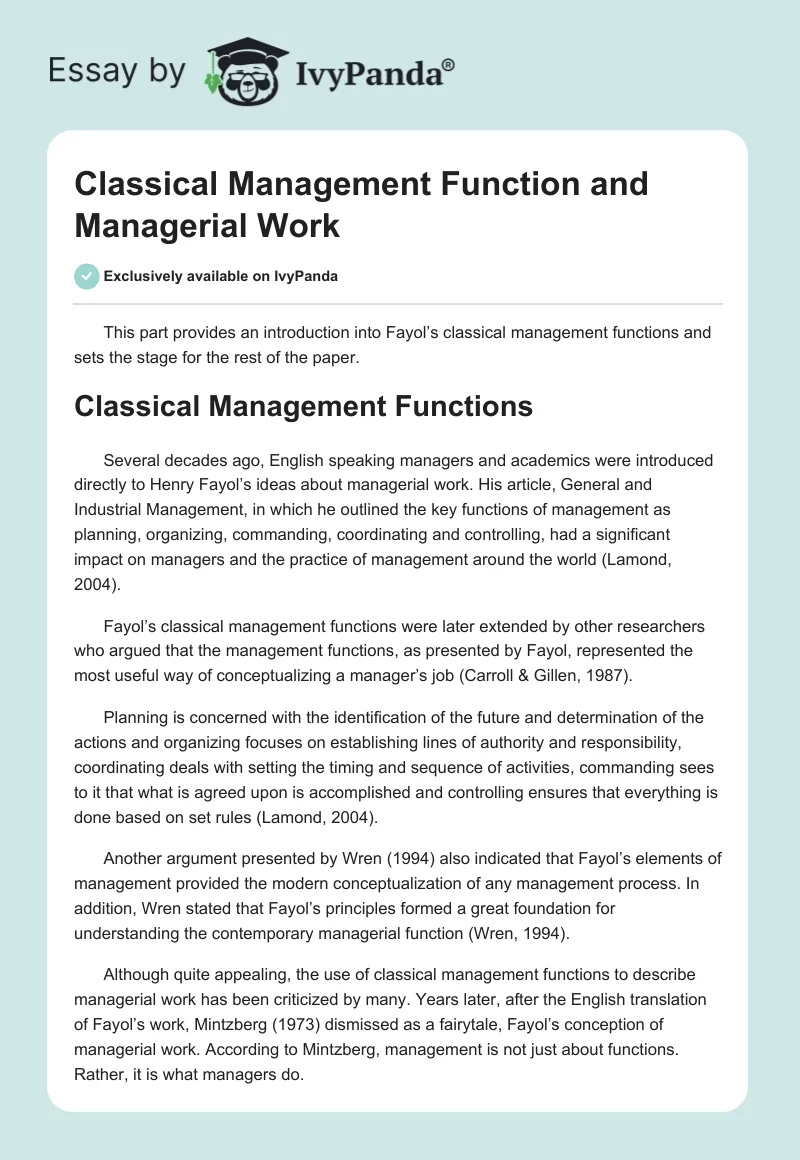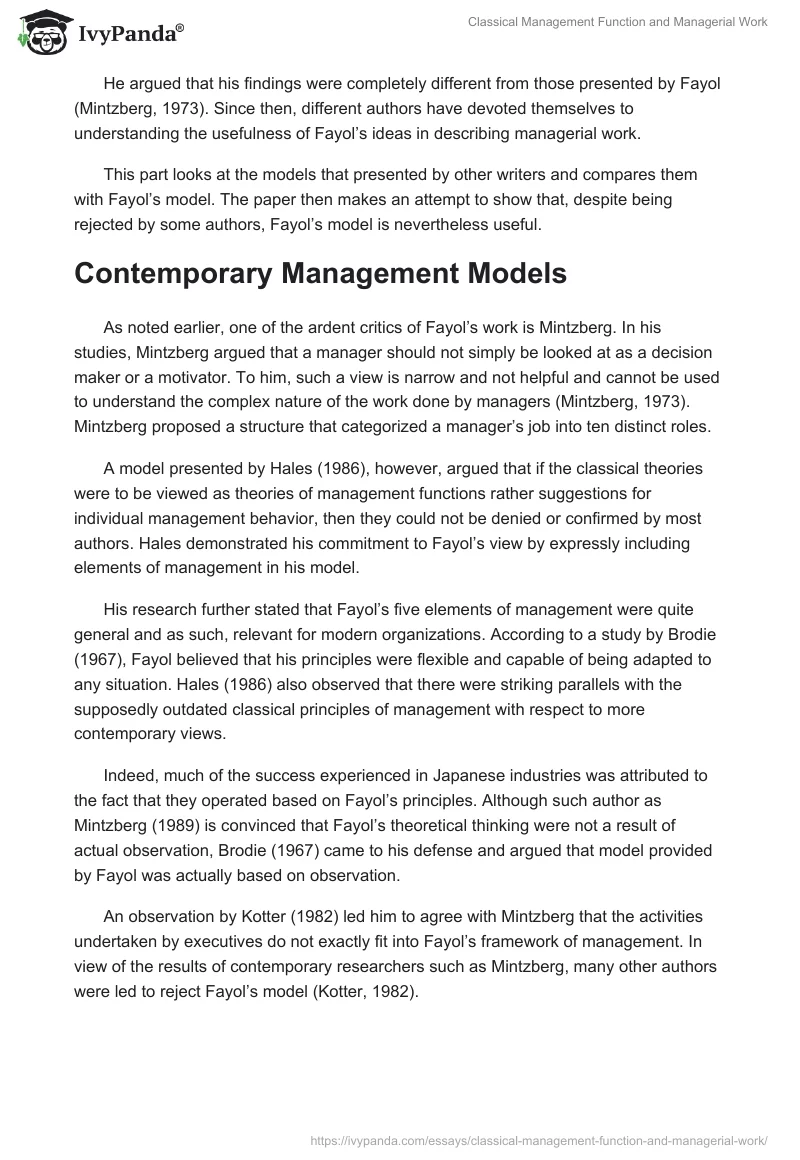This part provides an introduction into Fayol’s classical management functions and sets the stage for the rest of the paper.
Classical Management Functions
Several decades ago, English speaking managers and academics were introduced directly to Henry Fayol’s ideas about managerial work. His article, General and Industrial Management, in which he outlined the key functions of management as planning, organizing, commanding, coordinating and controlling, had a significant impact on managers and the practice of management around the world (Lamond, 2004).
Fayol’s classical management functions were later extended by other researchers who argued that the management functions, as presented by Fayol, represented the most useful way of conceptualizing a manager’s job (Carroll & Gillen, 1987).
Planning is concerned with the identification of the future and determination of the actions and organizing focuses on establishing lines of authority and responsibility, coordinating deals with setting the timing and sequence of activities, commanding sees to it that what is agreed upon is accomplished and controlling ensures that everything is done based on set rules (Lamond, 2004).
Another argument presented by Wren (1994) also indicated that Fayol’s elements of management provided the modern conceptualization of any management process. In addition, Wren stated that Fayol’s principles formed a great foundation for understanding the contemporary managerial function (Wren, 1994).
Although quite appealing, the use of classical management functions to describe managerial work has been criticized by many. Years later, after the English translation of Fayol’s work, Mintzberg (1973) dismissed as a fairytale, Fayol’s conception of managerial work. According to Mintzberg, management is not just about functions. Rather, it is what managers do.
He argued that his findings were completely different from those presented by Fayol (Mintzberg, 1973). Since then, different authors have devoted themselves to understanding the usefulness of Fayol’s ideas in describing managerial work.
This part looks at the models that presented by other writers and compares them with Fayol’s model. The paper then makes an attempt to show that, despite being rejected by some authors, Fayol’s model is nevertheless useful.
Contemporary Management Models
As noted earlier, one of the ardent critics of Fayol’s work is Mintzberg. In his studies, Mintzberg argued that a manager should not simply be looked at as a decision maker or a motivator. To him, such a view is narrow and not helpful and cannot be used to understand the complex nature of the work done by managers (Mintzberg, 1973). Mintzberg proposed a structure that categorized a manager’s job into ten distinct roles.
A model presented by Hales (1986), however, argued that if the classical theories were to be viewed as theories of management functions rather suggestions for individual management behavior, then they could not be denied or confirmed by most authors. Hales demonstrated his commitment to Fayol’s view by expressly including elements of management in his model.
His research further stated that Fayol’s five elements of management were quite general and as such, relevant for modern organizations. According to a study by Brodie (1967), Fayol believed that his principles were flexible and capable of being adapted to any situation. Hales (1986) also observed that there were striking parallels with the supposedly outdated classical principles of management with respect to more contemporary views.
Indeed, much of the success experienced in Japanese industries was attributed to the fact that they operated based on Fayol’s principles. Although such author as Mintzberg (1989) is convinced that Fayol’s theoretical thinking were not a result of actual observation, Brodie (1967) came to his defense and argued that model provided by Fayol was actually based on observation.
An observation by Kotter (1982) led him to agree with Mintzberg that the activities undertaken by executives do not exactly fit into Fayol’s framework of management. In view of the results of contemporary researchers such as Mintzberg, many other authors were led to reject Fayol’s model (Kotter, 1982).
Fells (2000), however, refuted such claims arguing that Hales work was conducted in part, based on Mintzberg and Kotter’s studies and, in his study, Hales identified common themes of what he termed elements of managerial work.
They included acting as a figurehead and leader of the organizational unit, formation and maintenance of contacts, monitoring, filtering and dissemination of information, resource allocation, handling disturbances and maintaining work flows, negotiating, innovating, planning, controlling and directing subordinates.
Fayol’s Model Today
Carroll and Gillen (1987) were in agreement with Mintzberg (1973) and Kotter (1982) and stated that the usefulness of the classical functions of management was questionable. There were others, however, who believed that Fayol’s elements and principles are still as valid today as they were in the yester years.
In a research where 52 managers at varying levels were studied, it became apparent that traditional management roles were frequently observed by many and especially successful managers who were at more senior management levels (Fells, 2000). Although the support that Mintzberg’s work received is obvious, a number of weaknesses were also seen in Mintzberg’s findings.
To some, the real value of Mintzberg’s study was not the ten roles but rather the use of direct observations which provided insights into the behavior exhibited by management. Studies also found that successful managers at top levels devoted more attention to the traditional roles such as planning and coordinating (Fells, 2000).
Fayol versus the Contemporary Models
Although a bit indifferent, Caroll and Gillen (1987) were of the opinion that Fayol’s model still represented the most useful way of conceptualizing a manager’s job. According to them, the more contemporary studies such as that by Mintzberg primarily help to clarify the nature of managerial work. In addition, they suggested that the models by Mintzberg, Kotter, and Fayol should be integrated.
According to Fells (2000), some authors were convinced that the allegations made by Mintzberg and Kotter regarding Fayol’s model were not justified. Rather than deny the classical view of management functions, Kotter and Mintzberg views tend to confirm them.
Conclusion
Despite being rejected by several authors, the ideas suggested by Fayol are still valid and useful for understanding managerial work. As it has been noted before, most of the classical management functions can be adapted to fit any specific situation as required.
In addition, all the models, including that by Fayol, can be interrelated at different levels. Regardless of the fact that there are noticeable differences in the models in terms of the words used and the perspectives taken, each model can be considered essentially equivalent to, or a subset of other models (Fells, 2000).
From the different comparisons that have been presented on Fayol’s as well as other models, it is apparent that Fayol’s model can be of great help to the discipline of management not only in the present age but also for the future.
References
Brodie, M. B. (1967). Fayol on Administration. London: Lyon, Grant and Green.
Carroll, S. J., & Gillen, D. J. (1987). Are the Classical Management Functions Useful in Describing Managerial Work? The Academy of Management Review, 12(1): 38 – 51.
Fells, M. J. (2000). Fayol stands the test of time. Journal of Management History, 6(8): 345 – 360.
Hales, C. P. (1986). What do Managers Do? A Critical Review of the Evidence. Journal of Management Studies, 23(1): 88 – 115.
Kotter, J. P. (1982). The General Managers. New York: The Free Press.
Lamond, D. (2004). A Matter of Style: Reconciling Henri and Henry. Management Decision, 42(2): 330 – 356.
Mintzberg, H. (1973). The Nature of Managerial Work. New York: Harper & Row.
Wren, D. A. (1994). The Evolution of Management Thought, 4thEd. New York, NY: John Wiley.


